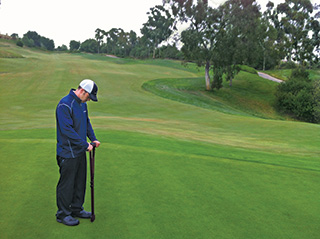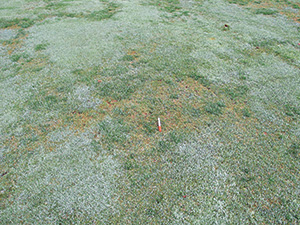Plant Health Series: Part 2
So much music is about summer.
Whether they’re singing “hot fun in the summertime…” or “summertime and the living’s easy…” we change the station. Summer isn’t fun, and it’s not easy. It’s stressful. For turf and for superintendents.
But with the right tools, people and preparation… it might not be fun… but it should be a success.
From your friends at Golfdom and BASF, we hope you have a successful summer.
Jeopardy! Style
À la Alex Trebek, here we go…
Answer: Intrinsic brand fungicides from BASF
Question: Which fungicides were the first to have plant health language on their label that is backed up by research?
Last month we wrote about separating the pretenders from the contenders in regard to “plant health.” Have you checked any of the products you are using to see if they actually have plant health on their label?
BASF Intrinsic brand fungicides are EPA-registered fungicides for disease control that include language for plant health benefits. Although first and foremost used for disease control, these products exhibit unique performance when stress events occur on your golf course. A stress event could vary from mechanical stress such as aeration to environmental stress such as temperature extremes.
I will once again remind you that BASF has published more than 70 pages of research on how these products perform and the benefits they can provide to your course. Have you visited www.intrinsicplanthealth.com?
Answer: Memorial Day, July 4th and Labor Day
Question: What is an easy way to remember when BASF Intrinsic brands can provide the most value to a superintendent? (I also would have accepted, ‘What time of year does Rich Kalik have his trusty Weber Smoker making award-winning ribs?’)
As a general guideline, applying Intrinsic brand fungicides around these holidays does provide the most benefit from a disease control and plant health standpoint. Honor Intrinsic brand fungicide is the most complete choice during this time, a particularly stressful one for turf you are actively managing. Honor fungicide delivers the two modes of action from pyraclostrobin and boscalid, the active ingredients in Insignia fungicide and Emerald fungicide.
Answer: Fall of 2013
Question: When will the next line of Intrinsic brand fungicides be launched by BASF?
We anticipate BASF’s continued research and development will result in the next line of products to be launched sometime this fall. We continue to look for active ingredients that provide innovative solutions to your unique needs. Since launching the Intrinsic brands in 2010, customers have continued to tell us how important these products have become to enhancing the results of their spray programs. Our offerings will be expanded beyond the current line of Honor, Insignia SC, Pillar, Pageant and Empress Intrinsic brand fungicides.
Answer: Over 60,000
Question: About how many acres were treated with Intrinsic brand fungicides in 2012?
Check with your peers or watch the plots at your local university plot tour. BASF intrinsic brands have become market leaders for their performance. When used during the key timeframes, we expect that you will see the results that so many other superintendents have seen already.
And a Daily Double to finish out —
Answer: Yes
Question: Will I be using BASF Intrinsic brand fungicides during the summer holidays in 2013?
Certainly, that is a daily double of superior disease control and actual labeled plant health benefits.
Rich Kalik is Technical Specialist, BASF Professional Turf & Ornamentals.
Seeing is believing
An assist from fungicides can help get grass through the summer as long as it’s one part of a greater holistic plan.
An unusually cool spring is in the rearview mirror. Now it’s time for summer, and with that, summer stress, including heat and in many areas, drought. ¶ But superintendents are prepared. ¶ All across the country, turf pros are looking at multi-pronged approaches to keep their plants healthy for the long run. In recent years, more tools have become available to superintendents to combat the effects of heat and drought while also improving plant health. Those tools include fungicides.
“I think the ‘old’ model that fungicides applied to plants only impact the fungi and don’t impact plants is widely shown to be false,” says Paul Koch, Ph.D., associate researcher of turfgrass pathology at the University of Madison-Wisconsin. “In fact, even contact fungicides such as chlorothalonil have been shown to elicit defense responses in plants, though not to a level that we can generally see.
“Regarding fungicides and heat stress, there is substantial evidence of the benefits of the phosphonate fungicides, namely Chipco Signature,” Koch continues. “Though the mechanism for this increased stress tolerance is poorly understood, the impact has been clearly demonstrated through research and anecdotal evidence over many areas of the country. In addition, there are also thought to be plant health benefits arising from applications of the QoI fungicides (Heritage, Insignia, Compass, etc.) Much of this is the result of data from the agronomic sector showing increased yield following QoI applications in the absence of disease, but there is some evidence that the impact is real on turfgrass as well.”
Reliable roots
When asked, most superintendents said they did believe that fungicides can have a positive impact on plant health. They had either seen it firsthand, or had viewed convincing research to prove it.
“I believe the research that the (chemical) companies and the universities have done has proven that applying some of these products does help heat stress,” says Matt Gourlay, CGCS at Colbert Hills in Manhattan, Kan. “I work with K-State a lot… any university research I see I highly regard as scientific fact.”
Scott Ramsay, CGCS at Yale Golf Course in New Haven, Conn., got to see the plant health benefits of a fungicide at BASF headquarters in Research Triangle Park, N.C.
“I was at Pinehurst, and BASF headquarters is nearby. I asked if I could get a tour,” Ramsay recalls. “This was when they were first rolling out the Intrinsic brand a few years ago. One of their plant guys pulled out some of their hydroponic pots… the roots were just crazy.”
Dr. Bruce Martin conducted research in 2007 at Clemson University on the effects of pyraclostrobin-based fungicides on A-1 bentgrass. Following one of the hottest South Carolina summers in recorded history, the pyraclostrobin-treated grass displayed higher quality for the entire season, as well as recuperative growth through the winter and spring.
There also is BASF research that shows pyraclostrobin-based fungicides can increase nitric oxide levels in plants, which inhibits the enzymes involved in the production of ethylene. Ethylene is a hormone that plants produce in response to many stresses, including drought.
Koch is optimistic about the research, while also eager to see more across the country.
“There is a lot of BASF-sponsored research that shows impressive benefits when using Intrinsic brand fungicides under extreme heat. From seeing the research at Clemson and Maryland, and even from talking with superintendents in the Midwest, there does appear to be a positive impact,” he says. “However, I have not observed any peer-reviewed, independently funded research showing either the positive impacts of Intrinsic fungicides or the mechanisms for how they work. In addition, because they are a relatively recent addition to the turf fungicide portfolio, I remain a little skeptical until the claims BASF makes are more widely substantiated across more golf courses in more turf markets.”
Chris Jennings, superintendent on the Ocean North Course and the South Course at the Resort at Pelican Hill in Newport Coast, Calif., believes there are subtle benefits to be gained by using these products. He believes they can be a part of a much larger, multi-pronged approach, when it comes to navigating the tough summer months. (To see more on the operation at Pelican Hill, see “An ocean between us” on page 31.)
“We’ve used some of those materials with these plant health claims,” Jennings says. “They talk about summer stress, about plant health — BASF’s Intrinsic products, which includes Insignia. I believe it can definitely help, as long as it’s part of a bigger program, a bigger plan.”
A holistic approach

Chris Jennings, superintendent of the Ocean North and South Courses at Pelican Hill Resort, takes a moisture reading.
When it comes to keeping turf healthy through the summer, superintendents utilize a holistic approach. It includes everything from spot-watering to having the foresight to choose the right turfgrasses based on the region.
For many supers, it also includes conditioning the plant to be thirsty.
Ramsay says he was sold on a presentation given by Michelle DaCosta, Ph.D., associate professor at the University of Massachusetts-Amherst, at the Long Island Turf Conference. In the presentation, DaCosta talked about pre-conditioning the plant in the spring and early summer by limiting water.
“At the time I was in the middle of a water emergency, with limited water resources,” Ramsay says. “She’s got me sold on the project, and it’s been working great.”
DaCosta stresses that she isn’t suggesting that superintendents impose severe drought on their turf before the heat of the summer, but a mild form of stress.
“To experience mild forms of stress — of drought — it activates the special physiology in the plant at a time of year when it can afford to, to redirect resources to build more roots,” DaCosta says. “It tricks the plant into simulating conditions in mild drought stress. We’re trying to build the root system, building the health of the plant, so when stress happens, soil temps in particular get above 75, 80 degrees, that the plants are better prepared. The physiology of the plant, the quality of the plant is more improved.”
Meanwhile at Colbert Hills, Gourlay, who has worked at the course since it opened in 2000, says a key for them has been choosing the right turf types.
“Because we don’t have any annual bluegrass, we don’t have to water our greens as much as other courses in the area that are struggling with annual bluegrass because it requires twice as much water and has a shorter root system,” he says. “We have the best turf varieties conducive for our environment. Our fairways and tees are zoysiagrass. It requires less water, less inputs, less everything. It can actually go dormant, and last year we had the fairways and tees go dormant six times.”
For Jennings, he is dealing with annual bluegrass — lots of it — so he knows how short the roots can be. His course is coastal, and the heat isn’t as severe. But some of the Poa types are adapted to coastal weather, so they thrive in cool, gloomy weather. That’s why his team focuses on moisture management.
“We have six irrigators, three on each course, dedicated to hand-watering and adjusting sprinklers,” Jennings says. “We have almost 10.5 acres of Poa greens and collars and extensions that we treat and water by hand, so it’s a big undertaking each and every day.”
The team at Pelican Hill has the luxury of five moisture meter tools. They set a moisture goal in the morning based on the weather and strive to keep that number as close as possible.
“Moisture management is something we deal with daily here, and then there’s all the cultural stuff that goes along with it,” Jennings says. “From a chemical perspective, what else can you do to help the plant? There are three or four things to alleviate stress during the most stressful periods. Those help out, but you can’t put too much stock in them, or you’ll be displeased.”
It’s definitely a multi-pronged approach superintendents are using to keep their plants healthy.
“A good fertility program, irrigation, optimal soil conditions, proper aerification…” DaCosta says, “…it has to be a holistic approach to make sure the turf is ready for summer stress.”
Let it Grow |
| This simple practice of raising cutting height can save turf, but it makes everyone nervous. |
| Dr. DaCosta understands the wants of golfers. But she even better understands the needs of plants. “Mowing is one of the most important practices (to keeping healthy turf), but it’s difficult to convince people to raise their height of cut slightly,” DaCosta says. “This would really help the plant and prolong its survival because it can make more sugars, which is the energy source for the plant and what’s really limiting it in the summer.” Golfers may expect the course to play a certain way, but they aren’t considering that the grass is gasping for air. “A lot of research has gone into summer stress decline. They’ve found one of the biggest problems and why these grasses decline, is based on an energy/carbohydrate imbalance. The plants aren’t producing enough (carbohydrates) because of the stress, and they’re also using up a lot of energy to survive,” DaCosta says. “Photosynthesis rates decline and respiration rates are really high.” The simple practice of raising cutting heights could mean the difference between life and death for turf. “It’s challenging, but if you can raise the plant, and along with rolling, you can maintain quality while also having good ball roll,” DaCosta says. |










